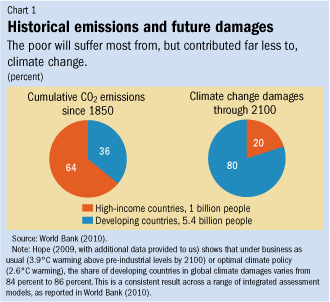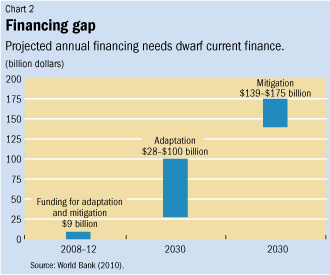A Changing Climate for Development
Finance & Development, December 2009, Volume 46, Number 4
Kirk Hamilton and Marianne Fay
Climate finance can provide the resources developing countries need to mitigate and adapt
CLIMATE change exacerbates the challenges of growth and development. It is already harming developing countries by introducing new threats, worsening old ones, diverting resources from development programs, and making it more difficult to escape poverty.

A Bangladeshi family travels to a safer location amid flood waters.
Although developing countries emitted only one-third of the greenhouse gases now in the atmosphere, these countries are currently producing more than half the world’s annual emissions, and this share is rapidly increasing. Developing countries cannot simply follow the carbon-intensive development path that high-income countries did. Yet they still need massive expansions in energy, transportation, urban systems, and agriculture. So, while high-income countries can and must reduce their carbon footprints, tackling climate change also requires a new development paradigm for developing countries.
But having poor countries finance a global public good—climate mitigation—or diverting development finance for adaptation is clearly inequitable. So effective climate finance solutions are critical to solving the climate challenge.
Imminent danger
Climate change is a serious and immediate threat to development. Unmitigated climate change could cause warming of up to 5°C this century—the difference between today’s climate and the last ice age—leading to a world vastly different from the one we live in. Even a 2°C warming, likely the best we can achieve, will result in new weather patterns, including increased variability and more frequent and intense extreme weather events. Dealing with this will require substantial adaptation efforts. But even with such efforts, some 100–400 million more people could be at risk of hunger, and 1–2 billion more may suffer from water shortages.
 Developing countries are the most vulnerable to a changing climate, potentially bearing some 80 percent of the damages from climate change (see Chart 1). Warming of 2°C would lead to minimal losses in high-income countries and a global average gross domestic product (GDP) loss of about 1 percent, but could result in a 4–5 percent permanent reduction in annual per capita income in Africa and South Asia. These losses would be driven primarily by the effect of climate change on agriculture, a sector important to the economies of both Africa and South Asia.
Developing countries are the most vulnerable to a changing climate, potentially bearing some 80 percent of the damages from climate change (see Chart 1). Warming of 2°C would lead to minimal losses in high-income countries and a global average gross domestic product (GDP) loss of about 1 percent, but could result in a 4–5 percent permanent reduction in annual per capita income in Africa and South Asia. These losses would be driven primarily by the effect of climate change on agriculture, a sector important to the economies of both Africa and South Asia.
Adapting later not an option
Richer countries are more resilient to shocks and better able to adapt to changing circumstances. This has led many to argue that the best way to help developing countries tackle the changing climate is to ensure rapid growth. Unfortunately, growing first and worrying about climate change later is not the answer.
Growth will likely not be fast enough to help the poorer countries. Consider the situations of Bangladesh and the Netherlands, two of the countries most threatened by sea level rise. Bangladesh has adopted a highly effective early warning and flood forecasting system, but with annual per capita income of only $450, its options for further action are limited. Even the Netherlands, with per capita income 100 times that of Bangladesh, has had to begin a program of selectively relocating some residents because continued protection of all residents is unaffordable.
The inertia present in our climate system is another reason prompt action is necessary. Scientists tell us that putting off mitigation for 10 years would likely make it impossible to keep warming from exceeding 2°C. The carbon dioxide emitted today will stay in the atmosphere for a century, and temperatures will continue rising for a few centuries after greenhouse gas concentrations in the atmosphere have stabilized. So today’s decisions determine tomorrow’s options.
The infrastructure resulting from growth and development introduces another element of inertia, locking in carbon footprints for many decades. Factories and power plants last 15–40 years, and road, rail, and power distribution networks, 40–75 years. Decisions on land use and urban form—the structure and density of cities—have effects lasting more than a century.
Opportunities to shift from high-carbon to low-carbon capital stocks must be seized sooner rather than later. Traditional high-carbon growth in developing countries will exacerbate the climate problem, and delaying action by a decade or two could increase mitigation costs by as much as 2 to 5 times, according to some models. Developing countries are growing fast and their needs are huge and immediate. They are expected to double their energy consumption over the next 20 years. And China is on a path to double its stock of buildings between 2000 and 2015.
Climate-smart development
Developing countries need to worry not only about the effects of climate change, but also whether they are locking themselves into high-carbon futures. The choice is not simply between a low-carbon, low-growth world and a high-carbon, high-growth world. Plenty of inefficiencies drive today’s high carbon intensity. In Russia alone, a 45 percent reduction in energy consumption could be achieved without affecting productivity and lifestyles, mainly by increasing energy efficiency in electric generation, factories, and buildings. In contrast, Brazil, China, and India are becoming market leaders in a variety of low-carbon technologies such as bioethanol, electric cars, and solar water heaters. And North Africa has embarked on a massive program to develop its solar potential.
Such a climate-smart development path—one in which developing countries avoid being locked into a high-carbon, low-competitiveness future—will require substantial efforts on the part of both high- and low-income countries. Commitment to stringent emission-reduction targets in high-income countries is a critical first step. This will trigger investments in the new technologies needed to make development and climate policy compatible. It will also help develop carbon-finance markets. But more will be needed to help developing countries finance the transition to a lower-carbon path.
Financing climate action
Climate action aimed at limiting warming to 2°C this century will be efficient and effective only if all countries play their part in mitigation. The role of climate finance, flowing from high-income to developing countries, is to reconcile equity with efficiency and effectiveness in dealing with the climate challenge.
 The current climate financing architecture is built around the Clean Development Mechanism (CDM) of the United Nations Framework Convention on Climate Change (UNFCCC) and about 20 other bilateral and multilateral climate funds. These instruments will generate roughly $9 billion a year between end-2008 and end-2012 (see Chart 2). Carbon markets under the CDM, whereby firms can buy offsets in developing countries against any carbon cap they face, are the primary market-based instrument for climate action and will generate roughly half of the $9 billion annual figure.
The current climate financing architecture is built around the Clean Development Mechanism (CDM) of the United Nations Framework Convention on Climate Change (UNFCCC) and about 20 other bilateral and multilateral climate funds. These instruments will generate roughly $9 billion a year between end-2008 and end-2012 (see Chart 2). Carbon markets under the CDM, whereby firms can buy offsets in developing countries against any carbon cap they face, are the primary market-based instrument for climate action and will generate roughly half of the $9 billion annual figure.
Huge needs
Chart 2 shows the projected annual needs for mitigation and adaptation finance in developing countries in 2030, based on a range of climate models and assessment tools (see World Bank, 2010, Chapter 6). The figures dwarf current finance, with adaptation investments ranging from $28 billion to $100 billion, and mitigation costs of $139 billion to $175 billion a year. To put this in context, Hope (2009, with additional data provided directly to us) estimates that mitigation costs in developing countries, consistent with limiting warming to slightly more than 2°C, could amount to 0.4 percent of high-income country GDP in present value terms over the century. However, because low-carbon technologies are typically very capital intensive, even when they have lower operating costs, the up-front investments that need to be financed in developing countries could equal two to three times the net mitigation cost figure.
Filling the climate financing gap will require all the tools at our disposal, spanning efficiency gains, reform of the carbon markets, and the creation of innovative financing instruments.
How to increase climate finance
There is ample scope to increase the efficiency of existing climate finance. Each of the roughly 20 bilateral and multilateral climate funds currently operating has its own governance and administrative systems, driving up overall costs. Consolidation of climate finance must become a priority. The main source of finance for adaptation to climate change is the Adaptation Fund established under the UNFCCC. This fund can accept donor contributions, but its main source is a 2 percent tax on CDM carbon trades. As a tax on a good rather than a bad thing, this has obvious efficiency costs, and simulations (Fankhauser and Martin, 2010) show that the lost gains from trade resulting from the tax fall disproportionately on the developing country suppliers of carbon credits.
Although the carbon markets under the CDM have been highly successful, reforms will be needed if this market is to be scaled up. Two broad types of reforms can be foreseen: streamlining the existing project-based portfolio of the CDM and expanding the market to policy-based or sectorwide approaches. Costs, delays, governance, and effectiveness—that is, whether carbon trades actually reduce emissions in the recipient country—are major concerns for the project-based CDM. Defining baselines and monitoring outcomes will be key to the success of sector- and policy-based markets, as well as for two of the largest potential sources of climate finance for developing countries: avoided deforestation and soil carbon sequestration (transferring carbon dioxide from the atmosphere into the soil). Without protocols to bring forests and soils into the carbon markets, initiatives are now limited to providing technical assistance and financial incentives to change forest and land management practices in developing countries.
Taxing the untaxed will likely be part of any scaling up of climate financing, with international bunkers (fuel stocks for international air and marine transport) being a prime target. Linking national carbon markets will increase their scale and liquidity. The European Union Greenhouse Gas Emission Trading System (the world’s largest carbon market) is a potential partner for emerging cap-and-trade systems. Auctioning “assigned amount units,” the national emission caps agreed under the UNFCCC, rather than giving them away, could generate additional finance, as could a global carbon tax, but these options face objections relating to fiscal costs and sovereignty.
Generating funds for climate adaptation presents particular difficulties. While emission trading for mitigation brings in the private sector and provides strong incentives for efficiency as market participants seek the lowest-cost abatement options wherever they occur in the world, no similar market incentive exists for adaptation. Unlike mitigation, the benefits of adaptation are local, and so the question of how and where to make adaptation investments becomes paramount.
Filling the climate financing gap through fiscal transfers presents problems of donor fatigue. Climate financing must be additional to official development assistance (ODA) if growth and development are not to suffer. The potential size of climate finance is commensurate with ODA as a share of high-income-country GDP. But, with some notable exceptions, high-income countries currently fall far short of meeting their ODA commitments.
Engaging the private sector in scaled-up carbon markets is an attractive way to fill the financing gap for mitigation. More generally, pricing carbon through taxes or emission charges will be transformational, influencing the consumption and investment decisions of billions of households and firms. But pricing carbon alone will not generate the needed flows of finance across borders. For this to be achieved, equitable allocations of emission rights and innovative market mechanisms will have to supplement fiscal transfers.
Integrating development and climate action
Developing countries face the majority of the damages from climate change, making adaptation not an option but a necessity. By financing low-carbon alternatives, climate finance can help take the carbon out of growth. It can also provide the resources needed to adapt. But it will need to be backed by a spectrum of climate actions, including the development and deployment of low-carbon technologies, increasing energy efficiency, changing the way we design cities and transportation systems, reforming the institutions needed to deal with climate change, and maintaining political support for climate action. We have no choice but to act now, act together, and act differently on climate and development.
References:
Fankhauser, Samuel, and Nat Martin, 2010, “The Economics of the CDM Levy: Revenue Potential, Tax Incidence, and Distortionary Effects,” Energy Policy, Vol. 38 (January), pp. 357–63.
Hope, Chris, 2009, “How Deep Should the Deep Cuts Be? Optimal CO2 Emissions over Time under Uncertainty,” Climate Policy, Vol. 9, No. 1, pp. 3–8.
World Bank, 2010, World Development Report 2010: Development and Climate Change (Washington).
Kirk Hamilton is coauthor, and Marianne Fay is codirector, of the World Bank’s World Development Report 2010: Development and Climate Change.


